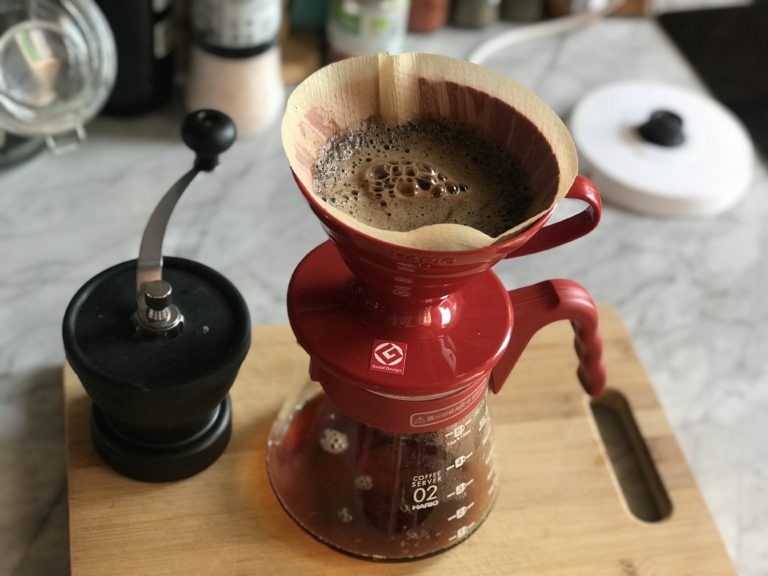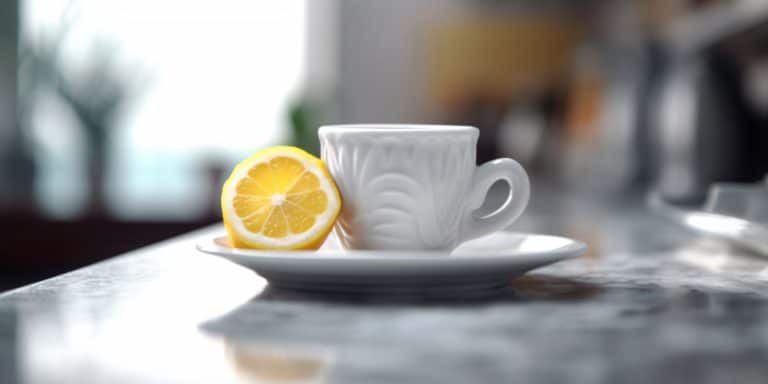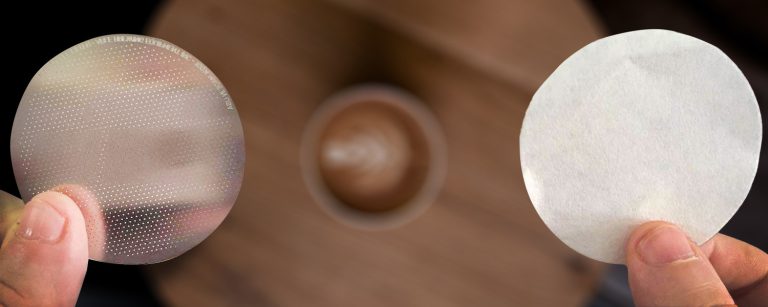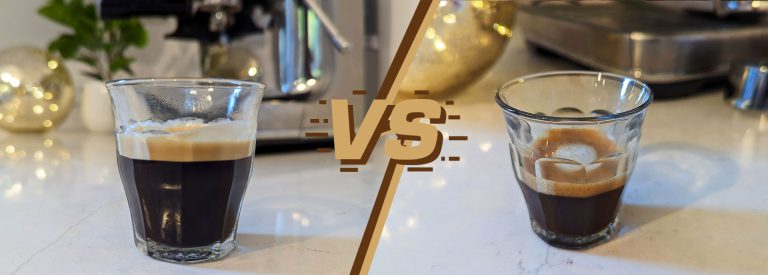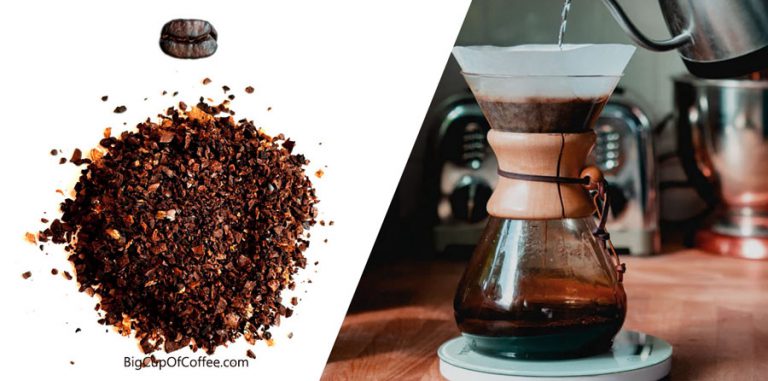How to Recognize a Good Espresso Shot? Here Are Features to Look For
I’ve dedicated a lot of hours to perfecting my espresso. Truth is, there are a lot of factors to consider in order to achieve it.
So in the end, how can you tell if you have a perfect espresso shot?
Let’s explore what goes into crafting and identifying the perfect espresso. From the basics to specifics, I’ll cover everything you need to know about recognizing and fully enjoying a great shot of espresso.
But first, a word of WARNING!
Going this deep into espresso will mean that you will not be able to enjoy it anymore at 90% of cafés, since most people working at non-specialty coffee shops are not trained to pull great shots. That’s a fact.
I regularly walk out of new cafés when I see how they prepare their espresso…
Don’t say I didn’t warn you.
The Basics of Espresso
Let’s start with the basic question about espresso. What is it exactly? Espresso is a concentrated coffee beverage made by forcing hot water through finely-ground coffee under high pressure (9 bars). If everything goes well, this creates a thick and rich espresso with a beautiful crema on top.
The pressure differentiates it from both pour over and drip coffee, which only use gravity for extracting your coffee. And since it’s brewed with less water than regular coffee, each sip packs a powerful punch of caffeine and flavor.
Mastering espresso also requires an appreciation for precision and quality ingredients. By using freshly roasted beans and setting the proper variables, you can enjoy every sip of your deliciously crafted cup.
Components of a Great Espresso
Now that we’ve covered the basics of espresso, let’s talk about how a great espresso shot is made. There are several components that must come together to create the perfect cup:
Fresh Coffee Beans
You need to use freshly roasted coffee beans, where the roast date is preferably not longer than 1 month ago.
Also, the aroma and thus flavor of your coffee beans begin to degrade quickly after grinding, so it’s essential to grind just before brewing with a quality burr grinder. Blade grinders and pre-ground coffee are unacceptable in the world of specialty coffee.
Grind Size
Consistently-sized grounds ensure even extraction through yields uniform flavors throughout your drink. A fine grind size allows for the best extraction of espresso. Find the right balance though, because too fine a grind will lead to over-extraction and coarser grounds will under-extract your drink. Here is a detailed article on the proper grind size for all coffee brewing methods.
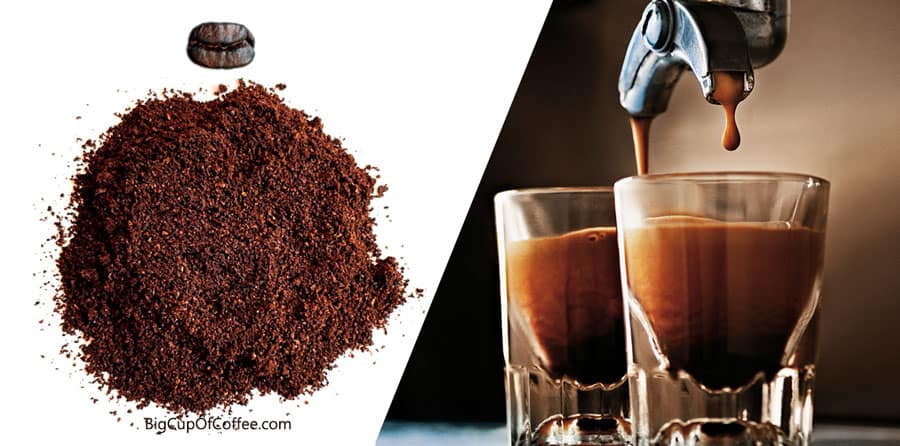
Brew Ratio
Additionally, the espresso ratio needs to be ideal for proper extraction, which is typically 1:2. Using about 9 grams of finely-ground coffee for a shot (1 ounce) of espresso and 18 grams for a double shot is the industry standard.
But you can go lower with the doppio. I only use 16 grams, it saves on coffee costs and still produces a nice cup.
Brewing Time
For optimal extraction, shoot for about 25 to 35 seconds when pulling your espresso shot, depending on the roast level of your beans. This timing ensures that all the flavors have been extracted from the beans without any bitterness being produced.
Temperature
The brewing temperature is equally important, so aim for approximately 195°F and 205°F (90°C to 96°C). Going too hot will result in an over-extracted or bitter espresso while going too cold will yield under-extracted or sour coffee.
The serving temperature is another factor that greatly influences how you will enjoy your espresso. It should be served right after brewing, as the small amount of liquid cools down very quickly.
Pressure
Remember also that pressure plays an essential role: 9 bars has been proven time and time again to be the perfect level of pressure. Anything less may result in insufficient resistance, yielding weak and watery drinks while anything higher might cause over-extraction leading to excessive bitterness.
Remember, creating a perfect cup of espresso takes practice, patience, experimentation as well as passion. But with careful attention to all these components, you can pull off amazing drinks.
Visual Indicators of Great Espresso Coffee
It’s time to identify what a great espresso is, starting off with how it looks.
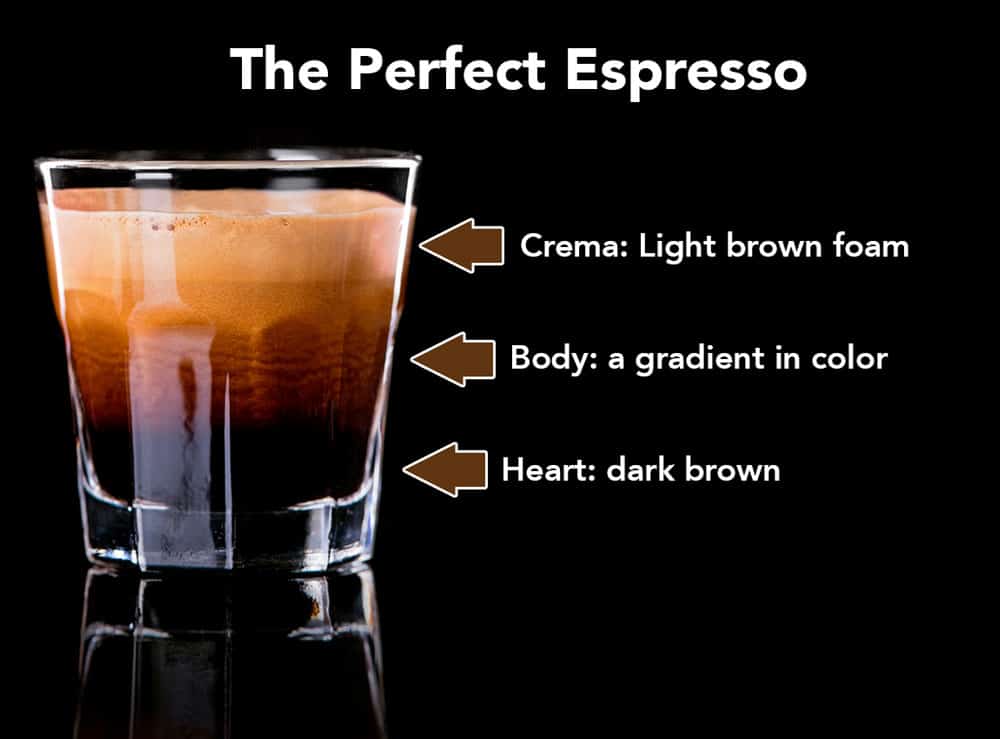
- The first thing to check is the crema– the layer of foam on top of the coffee. This crema should have a caramel color with a rich and thick consistency. If it’s thin or pale, you might be looking at an under-extracted espresso shot.
- You can also look at the patterns of your crema. Tiger striping or mottling in your crema indicates that your espresso is properly extracted.
- You should also look at the shot volume. The ideal volume for a single shot of espresso is around 1 ounce (30ml), while a double shot should be around 2 ounces (60ml). There is an element of preference here if you’re making your drink at home, but this is the standard at a café.
If the shot volume is significantly more or less than this, it could signal over or under-extraction respectively. - Clarity and absence of channeling are also crucial indicators of quality. Channeling occurs when water finds its way through the puck in uneven ways due to inconsistencies in tamping or grind size, resulting in weak or bitter cups.
After a few drops of espresso, a continuous flow should follow. A break from this even flow could be a sign of channeling.
This is easily seen on a naked portafilter, but you can also tell on a spouted one as it starts to sputter. - Finally, there should be a visible color gradation from top to bottom in your cup of a freshly brewed espresso. The top portion will typically be lighter with more crema, while it should gradually darken towards the bottom as the concentration thickens. These are called This signals that you achieved the right timing during extraction.
This gradiation of color diminishes quickly, you can only see it right as the machine stops brewing.
All these factors work together to create a well-balanced and flavorful espresso.
Tasting the Espresso Shot
If everything looks good, then you put its taste to the test. As you learn how to taste espresso, you’ll realize it’s not just about drinking coffee; it’s about savoring each and all of its parts.
However, it’s important to note that there is no right or wrong way to describe how an espresso tastes because it can be a subjective experience. With that said though, certain flavor descriptors are commonly used in the industry to define the characteristics of an ideal extraction.
- Mix it well with a small coffee spoon (demitasse spoon).
- Inhale the aromas through your nose.
- Take small sips and allow the flavors to fully develop on your palate.
- Swirl it around your mouth.
- Exhale through your nose after you swallow, to let the aromas
Here are the indicators of a great espresso shot through taste and mouthfeel:
- Complex aroma and taste profile: It’s always a win when your espresso captures the fruity notes, nutty undertones, and hints of chocolate or caramel from the roasted beans used. If they all work together to please your palate, then you’re sipping on some good espresso right there.
- A thick layer of crema: You should expect a thick layer of crema on top of your espresso meaning that all elements combined are working harmoniously together. The bitterness should be balanced by sweetness with little acidity present. Here is an article if you are not getting crema to form.
- Rich texture with well-balanced flavors: A perfectly extracted espresso shot should have a full-bodied and smooth finish with no sourness or extreme bitterness to worry about.
Sourness can be mistaken for the acidity and fruitiness in a great cup, but this is hard to describe in writing. You should go to a specialty coffee shop, watch how they prepare their espresso, and taste it. Baristas working there are always keen on talking about their coffee as well 🙂
With these factors in mind, you should be able to appreciate great-tasting espresso not just by instinct. If something doesn’t look, taste, or feel right, keep experimenting to find the brew that’s perfect for you.

Mastering the Four M’s of Espresso
In the world of espresso brewing, there are four M’s that baristas swear by to pull the perfect shot. Here are the four M’s as well as the added fifth M you need to know about:
Macinazione – Correct Grind Size
Preparing your beans correctly is crucial for perfecting your espresso, as the size of the coffee grind affects extraction time and pressure. You want to go for a fine grind but don’t overdo it or you will end up with an over-extracted cup. Meanwhile, a coarse grind will result in under-extraction.
Miscela – Proper Blend Composition
A good barista must know how to choose raw ingredients such as single-origin and blended coffees from trusted sources and then carefully create their custom recipe. Combining coffee varieties can balance out flavor profiles providing body depth without overpowering taste notes.
Macchina – Espresso Machine
The third M stands for Macchina, referring to an espresso machine. When looking for an espresso machine, consider factors like temperature stability and ease of use to help make each step of the brewing process smoother.
Mano – Barista’s Skill
You then have to have the Mano or hand skills, which is about refining barista techniques. Mastering this will allow you to extract good flavors every time, compensating for external variables affecting your cup’s quality.
Some of the skills you want to hone are steady hand pressure for even tamping, speed to maintain the temperature upon serving, as well as knowing how to recognize great espresso and how to adjust the components as needed.
Fifth M – Maintainance
Maintaining your espresso machine and grinder is just as important as using them correctly. Neglecting to maintain your equipment can cause issues with consistency, ultimately leading to subpar shots.
Make it a habit to regularly clean your machines thoroughly, descale them every few months, and address any wear and tear in their parts.
You might also want to invest in a water filtration system not only for the best results in your coffee but also for your equipment’s longevity.
Conclusion
And that’s it, you should know by now how to identify and craft espresso of great quality. It might seem overwhelming at first, but as you keep applying the things you’ve learned as you practice, you’ll be able to recognize a perfect shot at a café, and soon make exceptional espresso like it’s second nature.
Trust me, I’ve been there. As a final tip, while precision is important in espresso, don’t be too strict on yourself. Learning how to brew espresso requires a lot of trial and error. Yes, you’d probably get some (or a lot) of failed pulls, but the knowledge it imparts will help you familiarize yourself with the process, making it easier for you to consistently make perfect espresso shots that will rival your coffee shop.


